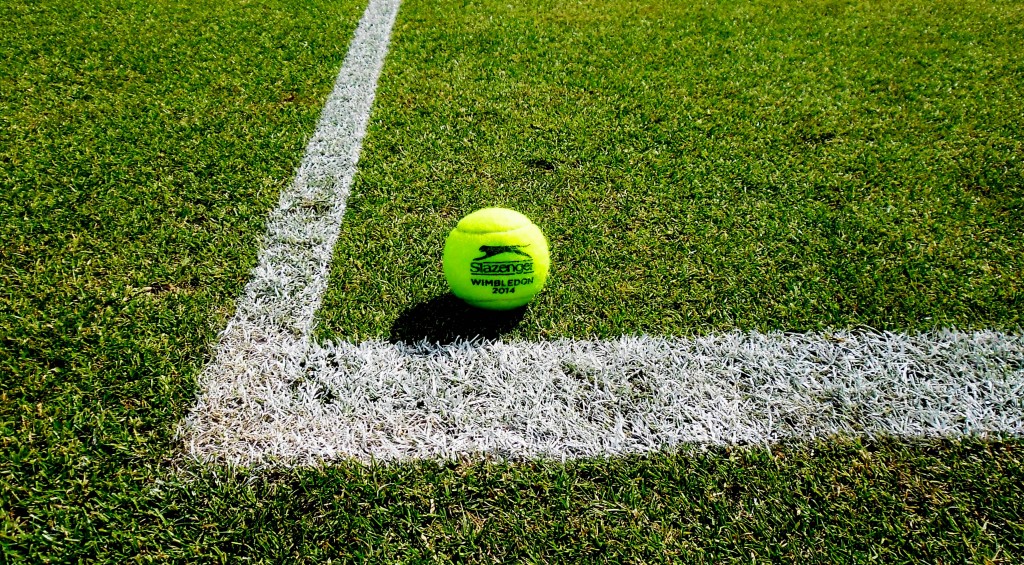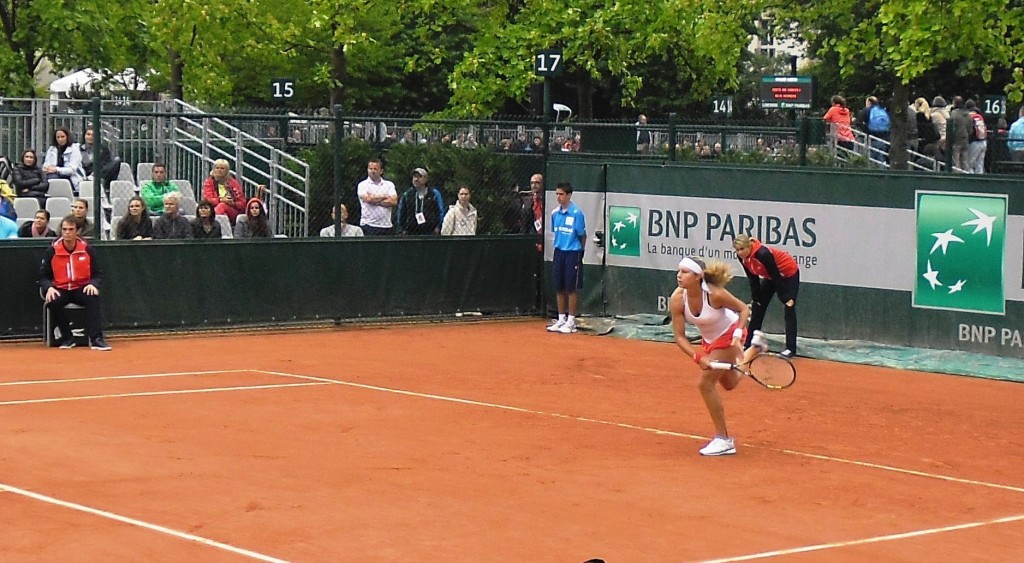As was the case with Roland Garros, stay tuned to MT-Desk for regular updates live from Wimbledon for the duration of the tournament.
Mertov’s T-Desk is also on Twitter !
Ending Tale of Roland Garros 2014
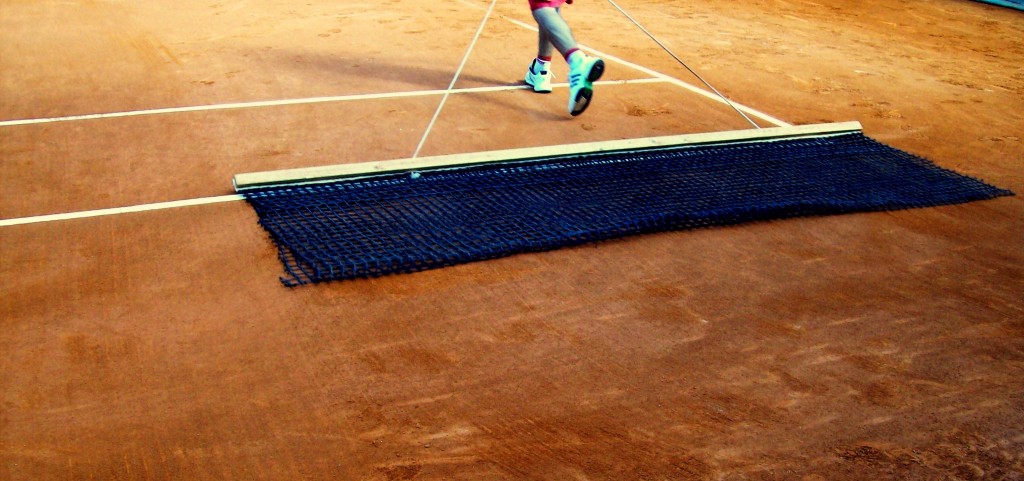
Roland Garros ended with two usual characters holding the winning trophies. Ironically, it will remain as one of the most upset-filled Slams in recent memory. Through all the upsets and the unexpected twists, the men’s number one and two seeds kept coming to a collision that all tennis fans expected since the beginning of the tournament. On the women’s side, once the top 3 seeds, Williams, Li Na, and Agnieska Radwanska, lost in the early days of the tournament, Sharapova and Halep were the two names that they predicted for the finals before any other name.
No need to go into details of each match, since most tennis fans have either watched them or read about them. It is worth noting however that for the first time in many years of worth of Slams (and yes, it’s “Slams” and not “Grand Slams”, a whole write-up needed for that mistake that keeps getting repeated over and over), the final weekend of the women’s draw witnessed as much excitement as the men’s, contained more dramatic matches with extremely tight finishes. The semifinals on Thursday – Sharapova vs. Eugenie Bouchard and Halep vs. Andrea Petkovic – undoubtedly provided more thrills for the spectators than the dull Friday of the men’s semifinals in which both matches remained sub-par in quality, and above-par in disappointment in terms expectations. Ernests Gulbis and Novak Djokovic played mediocre tennis for the most part, piling up the unforced errors. Djokovic’s physical condition deteriorated as the match went on and Gulbis could not raise his level of play to take advantage of it. The second match between Nadal and Andy Murray went from start to finish at maximum warp speed as Nadal totally outclassed Murray for a one-man-show that lasted 1 hour and 38 minutes.
On Saturday, Sharapova and Halep brought their “A” games to Philippe Chatrier and provided the crowd, as well as the millions in front of their TV screens, with a spectacle to be remembered for a long time to come. It made me think back to the last three-set-final at Roland Garros, some 13 years before Saturday, when Jennifer Capriati confirmed her comeback year that started at the Australian Open with a thrilling victory, 1/6 6/4 12/10, over the young newcomer Kim Clijsters of Belgium. It was a high flying period for the WTA with the Williams sisters in the beginning of their dominance, with Capriati and Martina Hingis challenging them, the Belgian duo Clijsters and Justine Henin joining the race and Sharapova getting in the mix in the mid-2000s. That match on Chatrier between Capriati and Clijsters was the stamp on the envelope that contained the sealed confirmation that WTA was a highly popular product among tennis fans. Around late 2000s, the product got old and stale, with many of the stars who built it, retiring or losing their skills. Yet, the new crop of players never managed to take over the few remaining names that kept dominating most tournaments. Saturday’s final match was not only a thrill in terms of quality of tennis played but also the stamp that the WTA desperately needed to confirm that it is on its way back. Sharapova may have lifted the winner’s trophy but the fresh crop of players such as Halep, Bouchard, Garbine Muguruza, Ajla Tomljanovic, Sloane Stephens, Caroline Garcia, and few others are not going anywhere, and will stay around for a long time. WTA has a golden opportunity to capitalize on a new, radiant group of players, and it could not have asked for a better Slam final match to launch their product.
The men’s final lacked nothing with regards to hype. The two best players in the world met at the highest stage of clay court tennis. The first two sets matched the expectations in quality and competition. Djokovic and Nadal traded blows, with each attempting to gain control over the other’s baseline game through aggressive shots. In the first set, Djokovic managed to stay inside the court and push Nadal around. In the second set, Nadal began going for winners much more often and succeeded in taking the middle of the court away from Djokovic. With the first two sets split, everyone expected a thrill ride the rest of the way. It never happened, due to two things. First Nadal completely found his rhythm and remained on high gear for the next hour, only to come land from space down to earth for the last few games of the match. Second, Djokovic’s physical state rapidly deteriorated from about 4-3 in the second set to 2-0 in the third set, to the point where he began shaking and stretching his legs and arms between points to relax and recover, stretching for balls to avoid extra steps, and as the usual result of fatigue, increasing the number of unforced errors in abundance. It was only after the middle of the fourth set, when the clouds came and the wind picked up, that Djokovic found a way to get back into the match – and Rafa had a hand in it too, with a few unexpected unforced errors. Yet, it was too little too late, as Djokovic did not have enough reserve in the tank to match the quality of his tennis from the first set. Nadal remained the king of clay and the number one player in the world, improving on his record of French Open titles and adding a new one to his expanding resume: he is now the only player in tennis to have one at least one Slam title for ten years in a row.
That being said, the stars of the last weekend of this Slam were the women. It was the first time in many years that women’s matches outclassed the men’s matches in excitement, thrill, and in quality. Unlike in men’s matches, there were no ‘empty moments’ in the three women’s matches of the last weekend, no one-sided shows, and plenty of quality shot making. Unlike in the men’s matches, each of the three women’s matches remained hard to predict all the way to the very last few points. Roland Garros 2014 was the recipe that the WTA desperately needed, the injection that rejuvenated a stale product.
I hope you enjoyed the series of updates from Paris.
Let the grass court season begin…
Women’s Final Preview: Sharapova vs. Halep
Since the eliminations of the top 3 seeds Serena Williams, Li Na, and Agnieska Radwanska in the early days of Roland Garros, the few left who were still daring to make predictions called on two names to meet in the finals: Maria Sharapova and Simona Halep. To their relief, the two players stayed the course and reached tomorrow’s final match, although not without some difficulty in Sharapova’s case.
Logic would dictate that with all her previous Slam titles and her mental toughness, Sharapova should overcome yet another challenge by a newcomer to the elite world of “big time” in WTA in the form of Halep. She has already held off challenges by the so-called the ‘new generation’ by recording remarkable comeback wins against Garbine Muguruza and Eugenie Bouchard, and one other against a proven player in Samantha Stosur. She came back to win in three sets after losing the first against all three. Especially her win against Bouchard deserves special mention.
The 48 hours leading up to the match, a photo of Sharapova taken with an 8-year-old Bouchard circulated all over the social and main stream media, courtesy of the editor at TV Guide who initially posted it on Twitter. The effects of this picture, coupled with Bouchard’s reference to Sharapova as her idol – ‘back then’ Bouchard specified, adding that they are “not friends” now – when asked about it, transformed the match into the image of a champion who stands to cede her younger rival the status of the revered champion and let the newcomer take her place. This was reminded to her more than once in the form of direct question – how did she feel about playing someone who took her as an idol when she was young? –, and in the form of newspaper articles and TV spots, in case she followed the media. She even had to respond to the last-second question by the colorful French TV personality Nelson Monfort on screen right before she walked on the court. He asked her how she felt about being the favorite and Sharapova, probably sick of the hype, bluntly answered that there could be no favorites in a match like this, and walked out. If she lost she would drop out of top 10, and Bouchard would enter it. Thus, it was under tremendous pressure that the Russian took her first steps to the court. To exasperate things further, the Philippe Chatrier crowd overwhelmingly supported Bouchard throughout the match. In short, Sharapova played a match where all the elements worked against her and she had everything to lose, while Bouchard stepped on the court as someone who had everything to gain from a victory.
So, one can understand when Sharapova celebrated her victory as if she won the tournament after her courageous comeback from a set down again. It was not happiness or contentment that she manifested. It was relief! I am not a big Sharapova fan, but I admired her tenacity, her sheer will to find a way to win, or refusal to lose. I believe that she will enter the court much more relaxed against Halep, an recently established top 5 player. She has already passed the toughest mental tests against Muguruza and Bouchard. She will play a match in which she is not the clear-cut favorite, although she is the slightly on paper. Her main advantage is her experience and her awareness that she can accomplish what is necessary when clutch moments arrive.
In contrast, Halep has steamrolled through the tournament, just as she has steamrolled through the last 12 months. If one was to pick the best player on the WTA Tour without a Slam title in the last 12 months, it would be Halep without a doubt. Yet, she has never been to this stage in a Slam tournament. Will that be a factor? It sure did not in her first semifinal in a Slam against Andrea Petkovic. She played the best tennis of the tournament by any player in the first set of that match. Her biggest strength is her footwork. She is able to move around the ball in small steps and get in position better than anyone in the current generation and probably better than any player since Arantxa Sanchez-Vicario of Spain, the French Open winner of 1989, 1994, and 1998. Her forehand is lethal and she does not seem to have a clear weakness.
If the past was not considered and tennis history began in the last 12 months, it would be a 50-50 call. Halep has numerous titles on every surface, skyrocketed to the number 4 ranking. Sharapova recovered from an injury the latter part of 2013, and has won Stuttgart and Madrid. In Madrid and on clay, she did beat Halep in three sets. When the past and the aura are added to the equation, the balance tilts in Sharapova’s favor. She has been to this stage, and has won Slam titles. Halep will play in her first final. All indications show that it has the potential to be a final for ages. Let’s hope it turns out so.
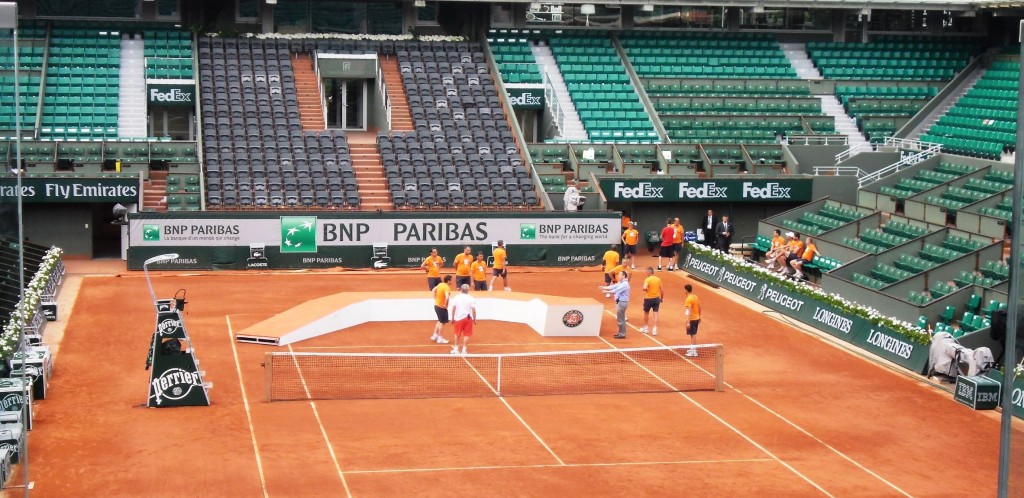 Friday evening – Trophy presentation ceremony rehearsal on Philippe Chatrier
Friday evening – Trophy presentation ceremony rehearsal on Philippe Chatrier
Race to Finish the Matches!
It was around 4:45 PM in Paris when Andrea Petkovic and Sara Errani began warming up for their match on Philippe Chatrier and Svetlana Kuznetsova and Simona Halep began theirs on Suzanne Lenglen. Nobody at that time believed that all four quarterfinals scheduled on both courts would end by the end of the day. Yet, approximately five hours later, the semifinals on both draws were set. How did it happen?
This was the worst possible day for the rain to make a comeback. In every Slam tournament, this topic comes up. One side of the draw plays one day and the other side plays the next day. At some point in the second week, in order to bring all the rounds together to the same level, the players on one side of the draw get an extra day of break because the side that has been coming from behind needs a day to catch up and a day of rest. At Roland Garros this transition is executed between the quarterfinals and the semifinals. Today happened to be the day where the matches on the side of the draw that has been a day were to be completed in order to play the semifinals on the same day. If rain delays the matches, you sweat bullets as tournament organizers because you are left with players who will not get a day of rest playing against others who have been resting a day, or even two on the men’s side. Thus, you can imagine how worried they must have been around mid-afternoon when it was raining cats and dogs at Roland Garros.
However, they received help. Twice!
First help arrived when the rain that stopped around 4:30 PM, still allowing – thanks to Paris where it truly gets dark after 10 PM – over 5 hours of tennis-wise-safe daylight to get one women’s and one men’s match in on each court. Next help, though unintentional of course, came from the players. Petkovic and Halep defeated their opponents with identical scores, 6/2 6/2, in less than 1 hour and 20 minutes. The turnover from the end of the two women’s matches to the beginning of the two men’s matches was probably realized in record time. The usual end-of-the-match, on-court interviews with French TV were canceled (Halep looked like she had absolutely no problem with that), and even though they were not told directly, the movements of the ball boys and the referees made it very clear to the women players that they needed to get off the court quickly to allow for the men’s matches to commence. Just like that, in an hour and a half after the women took court, the men’s matches began. Although one went 4 sets and the other 5, none of the sets went to 5-5 and both matches featured last two sets that ended with either 6/0 or 6/1 scores. At the end, all quarterfinals were miraculously completed and everyone breathed a sigh of relief.
I will finish with a few interesting observations.
– The Lenglen crowd was almost 100% pro-Halep. Strange that the 2009 winner Kuznetsova virtually received no love, although she has a larger arsenal of shots versus Halep’s solid baseline game with no variation. While it’s true that there were plenty of Romanian supporters (there were several Romanian flags), the French crowd overwhelmingly took Halep’s side. Considering the popularities of Bouchard, Petkovic and Halep, it confirms what I have felt for the last couple of years: women’s tennis fans are ready for a new crop of players to take over from Serena Williams, Maria Sharapova, Victoria Azarenka, and others that have been at the top of women’s game for many years.
– Gaël Monfils will probably close his career out as one of the most underachieving athletes to ever play the game. The guy is probably the most athletic guy on the ATP Tour, he can hit a big forehand as well as a big serve, and he has decent skills at the net. Yet, he remains 4-5 meters behind the baseline and reduces himself to an ordinary baseliner, only using a fraction of the arsenal of weapons that he possesses. Again today, he had Murray on the run and stretched him more times that I can remember, yet, he was content with waiting behind the baseline and letting the ball drop low to his ankles before hitting a regular baseline shot to put the ball back into play and let Murray recover. He is the kind of player that would be a nightmare to coach. He is the quintessential “almost” player that frustrates every coach. I imagine this is why he spends long periods of time without a coach throughout his career. They probably age quickly and go elsewhere. In fact, he played this French Open without a coach.
– As one media member said, Simona Halep gets into the “A-B-C’ of court tactics in her after-match press conferences more than any other women’s player. It’s refreshing to listen to her. She acts like she is talking to a large number of tennis coaches who understand the game well, rather than to a group of media members, many of whom have probably never played tennis.
Until next time!
Say What?
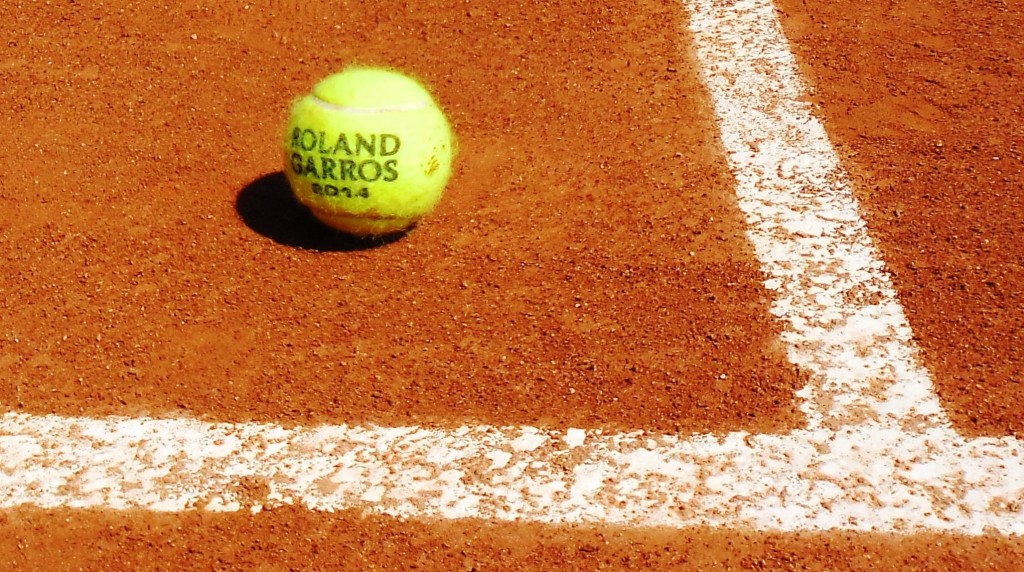
It’s a terrific Roland Garros so far, with shocking upsets and outrageous score lines. Two of the numerous oddities of the first week: how do you complete a 4/6 1/6 3/6 match and only win your serve three times? or how do you complete a match only winning 7 points on your serve? Ask Lucas Pouille and Paula Ormaechea.
I don’t have their comments, but in this article, the commenting does indeed come from the players and other experts. Enjoy!
– When reminded this was the first time in 24 slams that he made the second week, Gulbis replied: “First time in like seven years I have been in this room as a participant, not a spectator.”
– Gulbis again, on having better control over his outbursts: “You know, if I play like this, what kind of outburst can be there?”
– Gulbis yet again on whether France’s air is good for him since he won two tournaments there and is now in the second week of Roland Garros: “I used to only in tournaments in the USA and they asked me about the US air.”
– Carla Suarez-Navarro following her win over Taylor Townsend: “I have the impression that I was playing against a player whose style was a bit anarchical.”
– Ex-pro French player Henri Leconte on Maria Sharapova’s 51-minute 6/0 6/0 win: “Maria wanted to go shopping.”
– Journalist saying to Roger Federer: “You are a social ninja. Twitter…” Federer interrupts: “I think there are more active guys than me, but go ahead…”
– Third-seed Agnieska Radwanska, following her loss: “It doesn’t mean if first and second seed lost, doesn’t mean the third one is going to win. It’s stupid to say that.”
– Diego Schwartzman on playing Federer: “It’s like playing against a poster.”
– Ajla Tomljanovic, when asked if the room where her press conference was held following her win over Radwanska is the biggest that she has ever been in: “I believe so, yeah. [looking at the lights pointed at her] I have never had lights in front of me.”
– French journalist on Pauline Parmentier’s 4th round appearance for the first time in her career: “She will enter the top 100 and will play main draw at the US Open. Gone are the days of traveling small tournaments in exotic places.”
Until next update!
Tears Galore at Roland Garros
It has been a weird, incomprehensible tournament so far to say the least. First rounds brought one upset after another with shocking score lines. Stanislas Wawrinka and Li Na both faded away in the final sets of their matches, Wawrinka getting ‘bageled’ by Guillermo Garcia-Lopez in the fourth set and Na winning only one game in the final set of her encounter with Kristina Mladenovic. It’s the first time in history that both Australian Open title holders have gone out in the first round of the French Open.
The strange exits of Grigor Dimitrov and Kei Nishikori have equally raised eyebrows. Dimitrov has arrived to Paris in good form on clay, with a title in Bucharest and a strong semi-final showing in Rome. Yet, he lost to Ivo Karlovic who has not had a win at Roland Garros since 2007. Nishikori also lost in straight sets – in fact, he got crushed in the last two sets 6-1 and 6-2 – to Martin Klizan who is quietly having the best season of his career. In Nishikori’s defense, he did not get much practice prior to Roland Garros due to the injury that he suffered in the finals of Madrid three weeks ago.
Then, there have been tears… Plenty of them! Prior to today, Shuai Zhang and Stefanie Voegele shed tears of pain for different reasons during their press conferences. Zhang cried when reminded of her inability to win a first-round match in a Slam (her ninth first-round loss in a row in Slams), and Voegele could not hold back her tears due to personal reasons whose details the media members respectfully opted not to ask. It makes one admire Voegele (pictured below) that much more, considering that she stayed extremely calm and stable during her comeback win from 7-6 5-3 down against Anna-Lena Friedsam.
There are also tears of joy. Mladenovic cried after her win against Na, and again when she was being interviewed by Fabrice Santoro on the court. The second time, it seemed everyone in her player’s box joined her in shedding tears. One could see in the stadium several French spectators who were themselves visibly overcome with emotions.
Finally, there are also bitters-sweet tears. Michael Llodra cried during an emotional tribute prepared for him by the organizers due to his final year on the tour and his last appearance at Roland Garros. It was after his first round loss on the historic ‘bull ring’ court (Court #1). His little boy came down to the court to be with him, while Fabrice Santoro, the French Tennis Federation President Jean Gachassin, and the Davis Cup Captain Arnaud Clément honored him with classy speeches. When given the microphone to say a few words, he often had to stop speaking to gather himself as his tears flowed in abundance.
Tennis is a beautiful game!

